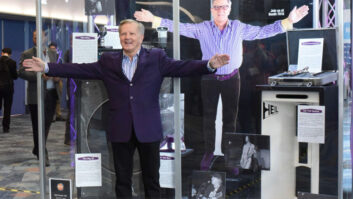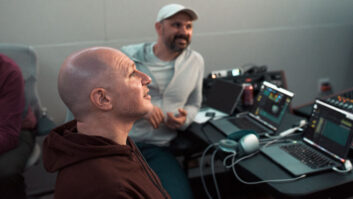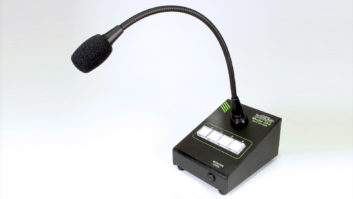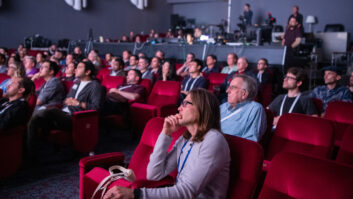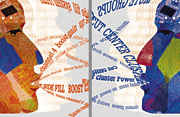
Illustration: Dmitry Panich
A long time ago, in a sound system not so far away, routing audio meant connecting copper wire from an analog output to an analog input. Anytime a connection changed, the system designer had to re-patch, taking into consideration connector type, gender, signal “direction,” impedance and channel identification. “Multipair” cable was developed to help steadfast audio engineers manage large numbers of channels. Unfortunately, copper multipair is heavy, stiff and expensive, and analog audio degrades as it travels over copper.
When digital technology came along, multichannel audio changed drastically. Not only was it possible to send more than one channel down a twisted pair of copper wires, but fiber-optic cable made it possible to send many channels of audio down a single, bidirectional connection. Further complicating matters was the fact that different types of data (audio, video, MIDI, control) could be routed via the same connection.
Somewhere along the way, the pro audio industry realized we could take advantage of hardware developments (such as Ethernet or FireWire) into which the computer industry had already invested. There is a distinct edge in such a philosophy: As huge corporations such as Cisco and 3Com continue to advance Ethernet technology, digital audio networks benefit from the increase in speed and decreased manufacturing costs of associated hardware. Cat-5 cable is cheap, readily available and easy to work with. The result is that there are an awful lot of “standards” for digital audio distribution. Many of these networks are “open,” meaning that they are not restricted to products from one manufacturer, and in some cases, a single interface may be able to control devices from multiple manufacturers.
To make clear the similarities and differences, compatibilities and lack thereof, Mix spoke with manufacturers and industry experts about digital audio system networking. One important concern is understanding the distinction between the different types of networks that are available.
“A common thing that I observe,” explains David Scheirman, VP of tour sound for JBL Professional, “is the lack of clarification between networked digital audio and digital control networks. The word ‘digital’ alone can throw non-technical people off the track. Digital control networks are found in many industries, from high-rise elevators to industrial plant controls to security systems. Digital audio networking is much more complex, requiring higher bandwidth, and has evolved more recently.
“Harman’s chosen path is that many of our newer products — AKG wireless mic receivers, JBL powered loudspeakers, digital EQs from BSS and dbx, Crown amps and Soundcraft/Studer consoles — can work together with a single connectivity scheme and a common user interface [System Architect software], so users can bundle all product classes within the same network,” continues Scheirman. “Our product set from the different brands is divided into two categories: products that can be digitally networked for control and monitoring purposes from a remote-control device, and products that can also use and incorporate networked digital audio signals. They can all be linked on the same network. The HiQnet system does not ‘care’ if you want to incorporate digital audio into the network or not, in addition to [controlling and] monitoring signals, but it is engineered to do so.”
Because digital audio networking is a relatively new technology, improvements are being made rapidly. “Digital audio networking as a whole has evolved quite a bit, not just with Yamaha mLAN but [FireWire IEEE] 1394 as a whole,” says George Hamilton, Yamaha’s music production product manager. “There were issues in the past where manufacturers of the FireWire controller boards were not holding to tight enough of a tolerance in the voltage supply. If that happens, the network disconnects temporarily and loses the device. There were also issues when Windows Service Pack 2 was released. It reset the FireWire bus back to S100; even if you were using FW800 devices, they operated at S100. Things like that have been corrected and mLAN is getting along well with Windows. Things have been a bit slower on the Mac side because developers have to wait for Apple to make changes to Core Audio before we can take advantages of certain mLAN features like the graphic patchbay. In addition, Apple also switched over to a completely different processor, which requires twice the effort to upgrade two Core systems.”
One of the problems with computer digital audio stems from the computer itself. “A computer is a very poor tape recorder, and it is not a real-time device,” Hamilton explains. “Computers may be very fast, and we continue to make them faster so that we can do things that appear to be happening in real time. That’s where latency comes in and causes problems. Most new computer hardware is oriented more toward video graphics. It’s much easier to fool the eye than it is to fool the ear. You can fool the human eye with 24 frames per second, but you cannot fool the ear with 44,100 samples per second. That means that we need wider bandwidth to take multitrack audio to the highest level.”
Although some digital audio network manufacturers embrace using existing network technology, others feel that there are different paths to travel. “Part of the problem with basing an audio network upon existing network technology is that those systems were not intended to support high-quality, high-bandwidth audio in real time,” explains Ray Legnini, senior marketing product manager at Aviom. “A certain segment of the market is content with the concept of distributing audio down the same pipeline used by their printers and computers, but those networks are not designed to move audio in real time. They can be used by people working in editing suites who need to move computer data. If an MS Word doc arrives at your desk a few milliseconds late, who cares? If you’re in a situation where the network serves sound effects, you could request a ‘door slam’ sound and have it in a few seconds. You’re not streaming audio and you’re not using it in real time. But if you’re overdubbing to a guitar track and it arrives a few milliseconds late, that’s a serious problem.
“We developed A-Net® from scratch with a different perspective,” Legnini continues. “We asked the question, ‘What is the best way to move high-bandwidth, high-quality audio and lots of it in real time?’ We found that common computer networks couldn’t cut it. There are problems with lack of bandwidth, signal degradation caused by things like jitter and wander [low-frequency jitter artifacts], and a traditional computer network’s lack of ability to deliver audio in what you’d call real time. Obviously, we know that audio must go through some sort of A/D and D/A process, so it’s not truly real time — there is some delay. How do you provide what feels like real-time monitoring for performers when they are overdubbing to tracks that were recorded yesterday? We combat these issues by making a system with latency [that is] as low as conceivable — given the hardware available in the world today — that can pass audio for a concert through a digital pipeline without introducing a slapback echo anywhere in the network.”
The issue of distributed digital audio goes well beyond finding a replacement for multipair copper technology. Simply replacing an analog snake with a digital network between the stage and front of house works great, but doesn’t represent the big picture.
“The benefits of connectivity make digital audio networking so powerful,” says Legnini. “Take a front-of-house-to-stage connection and add a recording feed. You need a method of splitting the signal. In the analog world, this means copper wire, connectors, and the time and effort to terminate the connections. Once audio is in the digital domain, it’s relatively easy to add another split. Consider something like a concert at the Olympics. The stage outputs must go to every country’s sound booth so they can mix in their own manner and blend in native-language commentary. Now you need 25 splits. If the audio is already in digital form, you simply extend the network and run a cable to each booth. Try that with analog.”
MORE THAN MEETS THE EAR
Bob Moses, IC program manager at THAT Corporation, has been involved with digital audio networking since 1995, when he linked a PC to a home hi-fi system via FireWire for a Bill Gates keynote address at a Windows Convention presentation. Moses points out that there’s a lot more to networking digital audio than meets the eye. “When you look at an audio network, you are really looking at something more like an operating system on a PC,” he says. “There is a tremendous amount of software involved in that network, and there are rigid constraints on what the network can do and how it accomplishes the job. As designers, we try to hide that as much as possible and have little icons on a GUI screen so a user can draw lines and everything is magically connected.”
However, creating an audio network requires dealing with many variables. “You have to pick a set of compromises from parameters including the application, the cost, the types of devices, the audio formats and whether there will be additional data such as control or video,” notes Moses. “The CobraNet designers chose one set of compromises, and the EtherSound designers chose another set of compromises. Comparing them is like comparing apples to oranges. Different networks are intended for different applications and reflect a different set of compromises. They are all great for what they were intended to do, but if you try to take them beyond their original intentions, they start to reveal limitations or problems.”
Lack of compatibility should be examined on a per-application basis. “CobraNet and EtherSound are popular for large installs, but in the studio there’s FireWire. If you try to take FireWire into a large venue and do a live show with it, you’re stretching it beyond what it was meant to do,” Moses explains. “CobraNet or EtherSound were never intended to talk with FireWire. If you look under the hood, they are very different technologies. Theoretically, it is possible to translate one protocol stack to the other, but it’s complicated and prone to problems.
“In our market, people want to go to a store and choose a brand that fits their application at a price point that has the right features,” Moses continues. “We’d like it to be like an XLR connector; we really don’t care what the electrons are doing in and out of that connector. We’d love for there to be one ubiquitous network that does what MIDI did for us. Yet even with MIDI, some people use Sys Ex for certain messages and that won’t talk to devices using controller messages. With networking, we are trying to create huge systems with very complex devices doing very complicated things. It’s difficult to accomplish that within a network, let alone accomplish that between networks that are not designed to work together. Instead of putting so much effort into trying to make systems talk to each other and thus compromise what they do, there should be more effort into educating people as to the applications for which these various networks are designed.”
THE FUTURE OF AUDIO NETWORKING
Looking through various digital audio networks profiled later, you’ll notice a lot of possibilities, many of which won’t play nicely with each other. This is reminiscent of a similar scenario in the late 1970s and early ’80s. At that time, synthesizer companies produced keyboards, sound modules and sequencers that used proprietary communication protocol to talk to each other. None of company A’s devices could be used with company B’s devices unless clumsy (and sometimes unreliable) converters were employed. When the MIDI spec arrived in 1983, those problems went away. To say that electronic music and the gear used to produce it flourished as a result of MIDI would be a gross understatement. Perhaps our situation is best summarized by Tom Stephenson, director of technology for Roland Systems Group U.S.
“In the professional live sound world, we have a plethora of formats all of which are proprietary,” Stephenson says. “Most manufacturers are trying to create their own standard, but none are free and open as most successful standards have been. In addition, computer companies don’t want to support myriad proprietary formats that require licensing fees. Although FireWire has been used for audio in the studio, it has a distance limitation and is a very complicated and expensive format to support. Witness the fact that there still aren’t any FireWire products that work the way MIDI works, allowing products from different manufacturers to interface with each other easily.
“As manufacturers, we need to consider working together to create an open, free standard, probably based around Gigabit Ethernet,” Stephenson continues. “As a standard it should work like MIDI, allowing for manufacturers’ products to easily interface with each other while offering paths for proprietary control data, as does MIDI Sys Ex. Gigabit Ethernet would take advantage of the economies of scale of the consumer electronics world, and would provide a high bandwidth and scalable format that could accommodate many channels of audio, as well as video and data control. A free and open standard would benefit the whole industry, making it easier to design systems using the best components from a range of manufacturers.”
THE SYSTEMS
Would you buy the newest digital reverb from Lexicon if you couldn’t use it with your Yamaha mixing console? With that and other questions in mind, we examine available audio networking protocols.
Adopting the physical aspects of Ethernet, Aviom‘s (www.aviom.com) A-Net® is designed specifically for streaming audio. Benefits of A-Net over Ethernet-based transfer include reduced latency, longer cable runs and improved clock performance. Aviom’s Pro16 Series™ is intended for point-to-point audio distribution with maximum speed. A Pro16 system introduces less than 1 ms of latency, including the A/D and D/A conversions, even when a number of devices are daisy-chained. Pro16 supports bidirectional audio transfer in systems as large as 32×32 or 48×16. It is designed for plug-and-play operation, facilitating cue monitoring through Aviom’s A-16II personal mixer. One input module can supply audio to as many personal mixers as required, with up to 150 meters of Cat-5 cable between devices.
The Pro64 version of A-Net employs the speed of Pro16 but adds support for higher-resolution sample rates, channel counts up to 64×64, control data for remote mic pre’s such as the Aviom 6416m and network management. Aviom’s Virtual Data Cables™ enable distribution of 14 channels of data such as MIDI, GPIO or RS-232. Pro16 Series output devices and Pro64 Series products may be used together in a single system using the ASI A-Net systems interface as a link.
BSS (www.bssaudious.com) Soundweb™ is a family of audio processing devices linked via a digital communication network. Soundweb-compatible hardware is self-contained and requires no additional hardware to route eight bidirectional channels of 24-bit/48kHz audio, plus control data via Cat-5 cable at distances up to 1,000 feet. Systems can be designed offline using Soundweb Designer software. Adding BSS’s SW9016 video/audio matrix switcher allows simultaneous routing of video and audio to several zones.
A basic Soundweb can be created by connecting two Soundweb 9088iis with a Cat-5 cable, networking eight channels of audio, plus control data. Larger systems may be created by patching the network “out” of the second 9088iis to a third, forming an audio ring in which eight audio channels travel from the first unit to the last and back. Along the way any device can either pass an audio channel from the previous unit or replace an audio channel with a new input. More complex systems may be created by adding a Soundweb 9000iis hub, which provides six network jacks, each of which can route eight bidirectional channels.
Developed by Cirrus Logic, CobraNet™ (www.cobranet.info) delivers digital audio in real time using standard 100Mbps Ethernet controllers, hubs and cabling. CobraNet has the ability to route 64 channels of bidirectional audio with 20-bit/48kHz resolution (128 channels) on a single Cat-5 cable. Gigabit Ethernet links provide an increased channel count. Audio may be sent distances of 100 meters via Cat-5 copper and as far as two kilometers using multimode fiber. CobraNet software can route any audio input to any audio output on the network.
CobraNet transmitters and receivers buffer audio data into Ethernet packets with a latency of approximately 5 ms, independent of A/D and D/A conversion. CobraNet software runs under Windows and includes CobraCAD™ system design software, Discovery monitoring and maintenance tools, and DSP Conductor™ for software developers.
The IQ Network from Crown (www.crownaudio.com) is an Ethernet-based communication protocol for remote control and monitoring of power amplifiers, digital signal processing, automated mixing and signal routing. Unlike most networks, IQ provides digital control over analog audio. Crown power amps accepting PIP (Plug-In Processing) modules facilitate connection to the IQ network. The PIP Lite card may be connected to the same network used to pass CobraNet audio. IQ for Windows running on a host PC enables control and monitoring of the system from a central location and is available as a free download.
Developed by Digigram, EtherSound (www.ethersound.com) uses standard Ethernet hardware to provide real-time transmission of digital audio and control data. EtherSound ES-100 audio transport employs a 100Mbps network to route up to 64 channels of uncompressed digital audio at 24-bit/48kHz resolution on a single Cat-5 cable. EtherSound ES-Giga System Transport uses a 1Gbps dedicated network to route as many as 512 channels of 24-bit/48kHz audio. Both systems route synchronous bidirectional audio, support a variety of sample rates and can employ existing infrastructure. Each EtherSound network channel is capable of transmitting one 24-bit/48kHz audio channel. Higher sample rates such as 96 or 192 kHz require use of two or four EtherSound channels, respectively, and sample rates may be mixed in any combination up to the number of maximum supported audio channels.
Digigram claims a latency of 104 microseconds in an EtherSound network. A built-in clock-recovery system maintains extremely low jitter, preserving audio quality over distances as far as 100 meters (longer when using fiber optics). End-to-end transmission time for a signal over an EtherSound network is approximately six samples.
Developed with Cirrus Logic, Gibson‘s (www.gibson.com) MaGIC features up to 32 bidirectional channels of 32-bit/48kHz uncompressed audio with support of sample rates up to 192 kHz. MaGIC transmits MIDI, video, control information and home automation data. Using standard Cat-5 cable and RJ-45 connectors, MaGIC’s latency is 250 µS end-to-end across a 100-meter network. The system may be used in freestanding or host-based modes, and is currently the only audio network capable of distributing DVD-A format data.
HiQnet™ from Harman (www.hiqnet.harmanpro.com) was developed to provide a common network protocol for products from the company’s group. It supports 64 channels of streaming audio at sample rates up to 96 kHz, plus Ethernet, USB, serial control and CobraNet audio — all using standard Ethernet hardware. A HiQnet system is managed using Harman Pro’s System Architect software, allowing a user to address all links in the chain from a single application running under Windows. System Architect enables configuration and control over products that include AKG WMS 4000 wireless mics; Crown CTs and Macro-Tech Series amps with PIP Lite, USP3 or USP3/CN cards installed; dbx DriveRack 4800 and 4820; JBL VerTec DP and VP Aeries loudspeakers; and Studer Vista 8 and Soundcraft Vi6 digital consoles.
Some of the capabilities of HiQnet include load monitoring and protection of Crown I-Tech and CTs Aeries amps, monitor and control over signal routing and processing using dbx DriveRack 4800, and creation of customized control panels for any attached device from the touch screen of the Studer Vista 8.
Peavey‘s MediaMatrix (http://mediamatrix.peavey.com/home.cfm) was introduced in 1993. Central to MediaMatrix is MWare and XWare software apps, which let an engineer design an audio system using simple block diagrams. Once the diagram is complete, MediaMatrix translates the diagram into digital processing information. This file may be saved as a Peavey Architectural View (.pav) file and uploaded to a MediaMatrix “frame” processor.
Analog sources are patched to an MM-8800™ Series digital interface or Break-out Box (BoB) for A/D conversion at 24-bit resolution and 32, 44.1 or 48kHz sample rates. Digital audio is then routed via 100Mbps Ethernet to a unit such as the Mainframe 760nt or Miniframe II, in which a DSP farm performs mixing, routing, EQ, compression and crossover. After processing, the signal may be sent back into the BoB for conversion and distribution. Peavey recently announced it had licensed EtherSound networking technology. MediaMatrix products such as the CAB™ 8 and CAB 16 Series employ CobraNet protocol and provide a means of interfacing MediaMatrix with CobraNet across a 100Mbps Ethernet network.
The RAVE — Routing Audio Via Ethernet — audio network from QSC (www.qscaudio.com) uses Ethernet hardware for transport of digital audio. A system can route 64 uncompressed audio channels at 48 kHz with 16/20/24-bit resolution on a 100Mbps network. RAVE employs CobraNet technology.
The network is built around QSC’s RAVE devices, each capable of handling 16 channels; these may be configured at the front panel or via PC software. A variety of RAVE units are available, such as the RAVE 161s-24 (16 analog inputs) and RAVE 88s (eight AES/EBU digital I/Os), enabling analog and digital I/O to the network. System latency is stated as 5.33 ms. Rear panel BNC connections let RAVE devices sync to external clock, and it is possible to parallel two RAVE units.
REAC — Roland Ethernet Audio Communication (www.rssamerica.com) from Roland — was developed as a means of addressing the signal degradation inherent to analog multipair in live sound applications. Its advantages include plug-and-play operation (no configuration necessary) and, as the stage box contains the mic preamps, audio is amplified at the source and transported in a high-quality digital format, eliminating the audio signal losses inherent in analog snakes and providing immunity to induced hums and buzzes. The REAC S-4000S-3208 is a 40-channel (32×8) stage box I/O rack transmitting 24-bit/96kHz uncompressed digital audio with a latency of 0.375 ms. Information is carried along with remote control and MIDI data via Ethernet on a standard Cat-5 cable.
The S-4000H 32×8 FOH unit sits alongside the house mixing console, receiving REAC data and converting it to analog audio. A remote S-4000R controller gives the house engineer remote control of the stage gain, pad and phantom-power settings. Cable runs of 100 meters are possible directly between the stage box and FOH units; this distance may be extended another 100 meters by adding a standard switched hub or to several kilometers when converted to optical data using standard fiber-media converters. By using multiple S-4000H and S-4000S units, larger networks such as 64×16 or 96×24 may be created. Standard Ethernet hardware may be used to digitally split the stage audio source signals. The REAC audio can also directly interface with a computer using a standard Ethernet port.
Yamaha‘s (www.yamahaca.com) mLAN music Local Area Network was designed for MI and pro audio. mLAN is a high-speed transfer protocol based upon FireWire IEEE 1394 and supports simultaneous transmission of multichannel digital audio, MIDI and control data. Any computer with a FireWire port running Windows or Mac OS can access mLAN, routing up to 150 channels of 24-bit/48kHz digital audio on a FireWire 400 bus and approximately double that number using FW800. (Current mLAN transfer rate is 200 Mbps.) mLAN devices can be hot-plugged, with communication automatically re-established when a device is reconnected to the bus. Though a PC may be part of the network, it is not required to operate devices.
mLAN may be used with any sequencer or DAW supporting ASIO drivers, Apple Core Audio and Core MIDI, and any app that uses WDM stereo audio. MIDI and audio signal flow may be configured via software and configurations are stored for instant recall.
Steve La Cerra is Mix magazine’s sound reinforcement editor.
